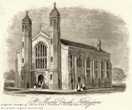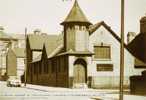 Nottingham Nottingham
St Mark
History
St Mark’s was built on a green open site on Windsor Street, now known as Huntingdon Street. It stood on the east side of the street, approximately where Hopewells the Furnishers are located in 2011. The new church district occupied an area that was part of the Clay field, an area previously used as pasture and also clay extraction for the local pottery and brickyards. On the west side of the street there was an existing network of densely populated back to back houses, set around small courts, alongside workshops and factories. In the south-west corner of the new district was the House of Correction, while the Nottingham workhouse and its gardens filled the north-west corner. Prior to the new church district being created it was part of St Mary’s parish. The Rev Joshua William Brookes of St Mary’s promoted the formation of several the new church districts and parishes in the 1850s including St Mark’s.
The church site, an area of 3176 square yards was purchased in 1855 by Mr GJP Smith at a cost of £375. He then presented the land to the church as a gift. The foundation stone was laid in 1855 and the building was completed early in 1856, shortly followed by the service of dedication on 4 April 1856 when the choir of St Mary’s led the singing. It had seating for 1,100 of which 550 seats were free. The architect was Robert Jalland of Nottingham. Jalland’s design was not well received by either his architectural peers, or the local press, the building being described by the former as in the ‘English thin Gothic perpendicular style’. In 1863 the Church Commissioners agreed an annual grant of £158.
In 1875 the vicar petitioned for a faculty to extended the chancel. The work proposed involved extending the original north and south walls to form a completely new chancel also housing a vestry, organ chamber and new choir stalls.The pulpit and reading desk were also scheduled to be re-sited. The removed east window was to be reused in the new east end gable. A Mr William Arthur Heazell was to be the architect and the builder a Mr Marriott. Costs were estimated as £720 of which £345 had already been collected by public subscription. The vicar, Mr James Allen, and Mr William Windley, a Nottingham mill owner, who funded a school building for St Luke’s Carlton Road and later paid the entire £13,000 cost of building the All Saints Church complex Raleigh Street, made themselves responsible for raising the balance. The document also requested permission to remove and re-site a number of monumental tablets, headstones and coffins. However there do not appear to be any surviving records for burials within the site. The faculty was granted on 29 June 1875.
During the eighty-three years St Mark’s served the community it had only four incumbents. During the final twelve years 1927-1939 it was united with St Mary’s who organised curates or visiting priests.
St Mark’s was busiest during the early 1880s. The land to the east and north of the church had been rapidly developed in the preceding twenty-five years creating a parish population of over 12,000 in 1881. This number included the Nottingham House of Correction and the Nottingham Workhouse, which had its own chapel. By 1883 the baptism register shows a growing number of children entering the church: 14 in March, 16 in April and 28 in July. Several of these baptisms involved all the children in the family, in one instance six siblings. A successful cricket club was in operation and the Band of Hope had 60 members. A mothers’ meeting was also held weekly. Sadly for all the activity the vicar found it necessary to pen an admonishment in the parish magazine imploring the paucity of the weekly offerings, the previous Sunday morning the collection plate yielding only 1s 10d. In view of the income levels of the local residents even a single penny would have been a significant part of many families’ income. An article in the parish magazine in 1885 illustrates the problem: some 200 children were attending the twice weekly ‘penny dinners’ organised by the church, and the vicar compassionately toured his parish distributing free dinner tickets to ‘half clad and shivering children’.
The same publication mentions the existence of a parish Mission Room but its location is not given.
 St Mark’s Church Hall St Mark’s Church Hall |
A Vestry Meeting Minute Book confirms that soon after the church was built a vicarage was completed nearby, but it does not state the location. In the early years of the twentieth century a Church Hall was built on the corner of Huntingdon Street and Watkin Street. The site had previously been occupied by a factory but is shown as vacant land on the 1881 OS map. This building survived until the 1970s. By the 1880s a school room had also been built on the north-east corner of the church site.
Major changes in the parish started in the late 1880s which had a lasting effect on the parish population. The first was the proposal to demolish buildings in large swathes of the parishes of St Mark’s and St Stephen’s to facilitate the excavation necessary for the building of the Victoria Railway Station and the deep cuttings that provided access. While the larger number of dwellings effected were located in St Stephen’s parish, which resulted in the closure and demolition of that church, many were in the parish of St Mark’s. Over 6,000 residents left the area. 1200 houses and twenty public houses were demolished, together with nonconformist chapels on St Ann’s Street and Milk Street.
In 1888 a further change took place. The new church district of St Catharine’s on St Ann’s Well Road was established. Part of the southern section of St Mark’s parish was allocated to the new district, part of St Luke’s providing the other part. The site of the new St Catharine’s was less than five minutes walk from St Mark’s. With these two events the congregation and viability of St Mark’s must have been considerably diminished. Neither of these events are recorded in the Vestry Meetings Minutes Books of the period.
Little is recorded of the next thirty years, but a newspaper report of 1896 recorded that “the choir was not surpliced, and assisted by ladies”.
No information has come to light to illustrate how the church dealt with the effects of the parish boundary changes or the years 1914 to 1918 when the country was at war. It was not until 1921 that the beginning of the end was announced. A proposal was published suggesting that some city centre churches may have to close, due to reducing parish populations. St Mark’s was on this list along with St Luke’s (closed 1923), St Paul’s George Street (closed 1922) and St Thomas’ Park Row (closed 1926). St Mark’s survived a little longer, but congregations were sparse. In January 1934 six services a week were held, but only thirteen people attended weekly communion. By early 1939 only two Sunday services were conducted. Collections fell correspondingly with income only £2 5s a week. The final service was on 2 September 1939. Few people attended and the last collection raised only £1 10s 10d.
The building was not demolished until 1956/7, but to date there is no information why this was, or if it was put to another use during the 1939-1945 war years.
The parish registers for baptisms (1856-1939) and marriages (1860-1939) are held by the Nottinghamshire Archives Office.
| 


 St Mark’s Church Hall
St Mark’s Church Hall





